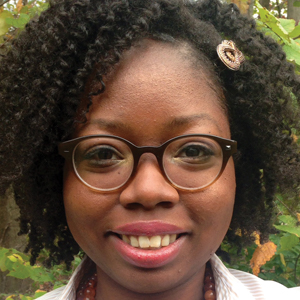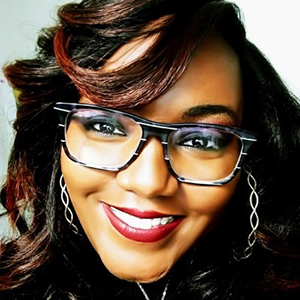#BlackInX Twitter movement creates visibility for Black scientists
In honor of Black History Month, I am showcasing Black scientists who have careers outside of academia or industry. This is my career story as well. I am a toxicologist, science communicator and science education advocate. As a Black woman in science, I grew up not seeing people who looked like me in spaces where I wanted to be, especially in the media. Now we are slowly seeing more Black scientists represented on television and social media and in different industries.
Last year as the COVID-19 pandemic started, we also were going through a racial reckoning. During this time, the #BlackInX Twitter movements were on the rise; more people were speaking up about the racial injustices, challenges and lack of visibility of Black scientists. Currently, there are more than 30 #BlackInX Twitter movements.
I am focusing on two: #BlackInMicro and #BlackInChem. Both movements started because the organizers realized that they did not see scientists who looked like them, and they wanted that to change. These movements made learning about Black scientists more accessible and changed the narrative of what a scientist looks like. They also created a safe space and an environment where encouraging the next generation of Black scientists was at the forefront.
In addition to the growth of #sciencetwitter and the #BlackInX Twitter movements, last year CrossTalk.Cell.com published multiple lists of 100, 100 more and 1,000 inspiring Black scientists in America. I encourage you to follow and collaborate with more Black scientists this year. As a Black scientist, I am grateful these movements were created and that the next generation of scientists will have many Black science role models. I look forward to the growth of these movements.
#BlackInChem

Devin Swiner, a Ph.D. candidate at Ohio State University, shared how putting out a call of action on Twitter started a chemistry movement: “#BlackInChem was inspired by all the other #BlackinX weeks, and the goal was to showcase and celebrate Black chemists. During #BlackinAstro, founded by Ashley Walker (an intern at NASA Goodard Flight Center and #BlackinChem co-founder), I tweeted that I would love to curate #BlackinChem, if I found some help.”

Soon other grad students and professionals started chiming in on Twitter. Swiner did not expect to get all these responses. From there, the group of co-organizers formed to make #BlackInChem. Along with Swiner and Walker, the organizers included Ayanna Jones, a Ph.D. student at Emory University; Kathleen Muloma Rink, a National Society of Black Physicists associate; Natérica das Neves Rodrigues Lopes, a Marie Curie research fellow at Lipotec SAU; Samantha Theresa Mensah, a Ph.D. candidate at the University of California, Los Angeles; and Heidi Nelson–Quillin, a scientist at the Azimuth Corp.
“It started because of a need to center Black people doing chemistry,” Swiner said. “We saw it as a great opportunity to show the world that we exist and do great science.”
#BlackInChemWeek was created to bring more visibility to black chemists and build a community. The virtual events ran Aug. 10–15 and included virtual events and Twitter chats featuring different chemistry specialties, an elevator pitch competition, a career journey panel and a networking event. After this successful week, @BlackInChem has over 6,200 Twitter followers and is continuing to grow.
Visit their Twitter page, @BlackInChem, and website, Blackinchem.com.
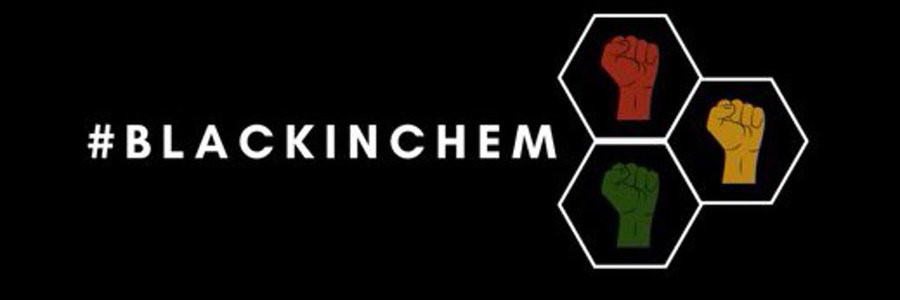
#BlackInChem scientists
STEM education: Angelicque Tucker Blackmon is the chief executive officer and director of research and evaluation at the Innovative Learning Center, a firm that provides research evaluation and services and STEM tutorial support for parents and students. Blackmon has a Ph.D. in educational studies from Emory University. Her work focuses on supporting STEM education leaders to secure external funding for programs serving students from kindergarten through undergraduates, creating strategic plans for program design and impact-based evaluations.
Law: Kerisha Bowen, is a law clerk at Dentons, the largest general practice firm in the world. She is the first Black woman to earn a Ph.D. in chemistry from Temple University and she has a law degree from the George Washington University. Her work focuses on the intellectual property branch of law that deals with rights and protection of creation of products. Read my article about Bowen.
Government and nutrition: Alison Brown is a program director at the National Heart, Lung and Blood Institute. She has a Ph.D. in food policy and applied nutrition. Her work at NHLBI focuses on nutrition and health disparities.
Government and agriculture: Dominique Carter is an agricultural science adviser at the U.S. Department of Agriculture. She has a Ph.D. in microbiology, immunology, and molecular genetics from the Medical College of Wisconsin. Her work focuses on strategic planning, performance measurement, evaluation of programs and science policy.
Cosmetic chemistry: Camille Martin is the co-founder and chief executive officer of Seaspire Skincare. She has a Ph.D. in biomaterials chemistry from Northeastern University. Her work focuses on designing sustainable skincare.
Government workforce development, diversity, equity and inclusion: Marguerite Matthews is the scientific program manager at the National Institute of Neurological Disorders and Stroke. She has a Ph.D. in neuroscience from the University of Pittsburgh. Her work focuses on managing federally funded programs and initiatives that enhance diversity of the STEM workforce.
#BlackInMicro
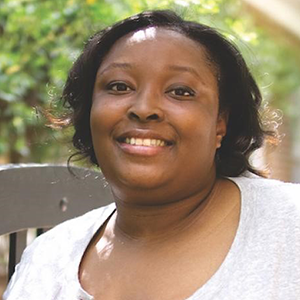
Ariangela J. Kozik and Kishana Taylor, two Black women postdoc microbiologists, were encouraged by #BlackInX to start #BlackInMicro.
Kozik has a Ph.D. in comparative pathobiology from Purdue University. She is a postdoctoral research fellow at the University of Michigan Medical School in the division of pulmonary critical care. She conducts research in Yvonne Huang’s laboratory on how the respiratory microbiome is involved in the presentation and pathogenesis of asthma.
Taylor has a Ph.D. in interdisciplinary biomedical sciences from the University of Georgia. She is a postdoctoral fellow at Carnegie Mellon University in Elizabeth Wayne’s lab. Her research focuses on the role of macrophages in SARS-CoV-2 infection and subsequent development of COVID-19.
“Earlier this spring and throughout the summer, there were many movements formed in the wake of continued racial inequality and violence,” Kozik said. “In the academic community, this included #ShutDownSTEM, #BlackBirdersWeek, and others that gathered a coalition of scientists and STEM professionals to speak out more openly about the challenges faced by their Black colleagues and to amplify the presence of Black scholars in their fields.
“In the context of a pandemic with disproportionate impacts on the Black community along with widespread misinformation about microbiology, we also felt a sense of urgency,” she added.
Others felt it too; a week later, 30 people coming from different career levels in microbiology came together to organize #BlackInMicroWeek. Running from Sept. 30 through Oct. 4, it included a roll call and discussions about STEM education disparities in the Black community, vaccines, virology, and HIV and the black queer community. @BlackInMicro has over 7,100 Twitter followers and is continuing to grow.
Visit their Twitter page, @BlackInMicro, and website, Blackinmicrobiology.org.
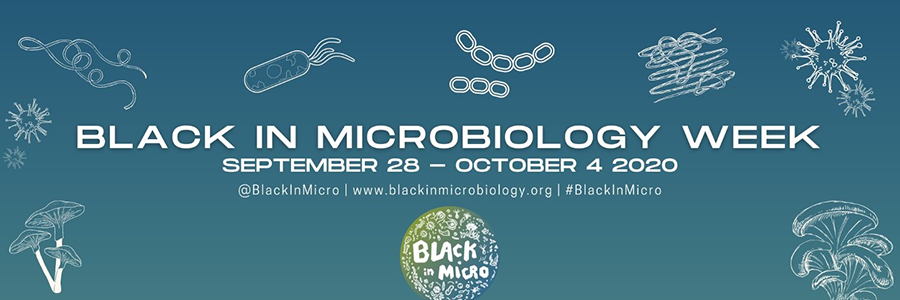
#BlackInMicro scientists
Government and vaccine development: Kizzmekia Corbett is the scientific lead for the coronavirus vaccine program at the National Institutes of Health. She has a Ph.D. in microbiology and immunology from the University of North Carolina at Chapel Hill. Her work focuses on respiratory virus (coronavirus, respiratory syncytial virus) pathogenesis and vaccine design.
Government and drug evaluation: Keisha Findley is an interdisciplinary scientist/microbiologist at the U.S. Food and Drug Administration. She has a Ph.D. in molecular genetics and microbiology from Duke University. Her work focuses on reviewing, evaluating and making decisions about nonprescription drug products.
Government and workforce development: Kenneth Gibbs Jr. is the chief of the undergraduate and predoctoral cross-disciplinary training programs in the National Institute of General Medical Sciences' Division of Training, Workforce Development and Diversity. He has a Ph.D. in immunology from Stanford University School of Medicine. He oversees NIGMS training programs to enhance diversity, including the new Maximizing Opportunities for Scientific and Academic Independent Careers, to which the American Society for Biochemistry and Molecular Biology is a contributor. Read ASBMB Today's interview with Gibbs.
Government and workforce development: Roland Owens is the director of research workforce development at the Office of Intramural Research at the National Institutes of Health. He has a Ph.D. in biology from the Johns Hopkins University. He oversees principal-investigator recruitment for intramural research. Read my article about Owens.
Diversity and higher-education administration: Devin L. Horton is the graduate diversity officer at the University of California, Davis. She has a Ph.D. in cell/cellular and molecular biology from the University of Michigan. Her job focuses on developing diversity undergraduate research programs.
STEM education and nonprofit: Chad Womack is the senior director of STEM initiatives and a historically Black college and university program at the philanthropic United Negro College Fund. He has a Ph.D. in biomedical sciences with a concentration in molecular epidemiology, virology and immunology from the Morehouse School of Medicine. His work at the UNCF focuses on innovation-based community and nonprofit organizations that will increase the number of Black high school students eventually pursing STEM majors.
Enjoy reading ASBMB Today?
Become a member to receive the print edition four times a year and the digital edition monthly.
Learn moreFeatured jobs
from the ASBMB career center
Get the latest from ASBMB Today
Enter your email address, and we’ll send you a weekly email with recent articles, interviews and more.
Latest in Careers
Careers highlights or most popular articles

Sketching, scribbling and scicomm
Graduate student Ari Paiz describes how her love of science and art blend to make her an effective science communicator.

Embrace your neurodivergence and flourish in college
This guide offers practical advice on setting yourself up for success — learn how to leverage campus resources, work with professors and embrace your strengths.

Upcoming opportunities
Apply for the ASBMB Interactive Mentoring Activities for Grantsmanship Enhancement grant writing workshop by April 15.

Quieting the static: Building inclusive STEM classrooms
Christin Monroe, an assistant professor of chemistry at Landmark College, offers practical tips to help educators make their classrooms more accessible to neurodivergent scientists.

Unraveling oncogenesis: What makes cancer tick?
Learn about the ASBMB 2025 symposium on oncogenic hubs: chromatin regulatory and transcriptional complexes in cancer.

Exploring lipid metabolism: A journey through time and innovation
Recent lipid metabolism research has unveiled critical insights into lipid–protein interactions, offering potential therapeutic targets for metabolic and neurodegenerative diseases. Check out the latest in lipid science at the ASBMB annual meeting.

